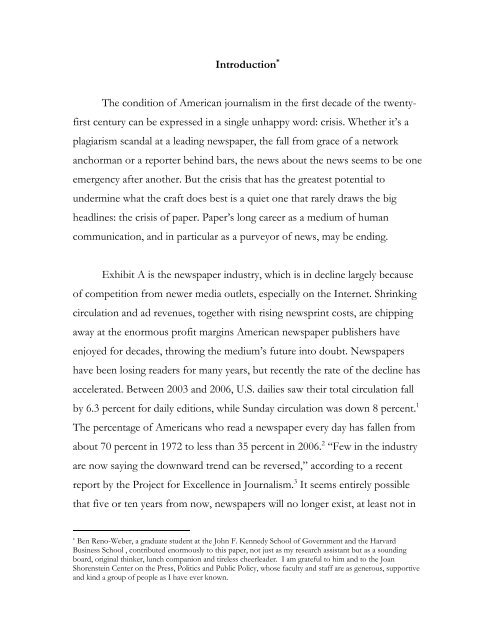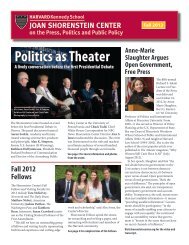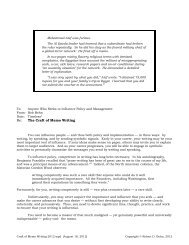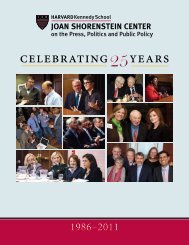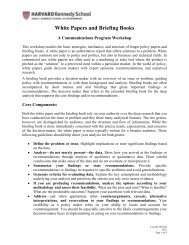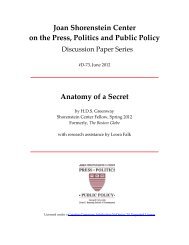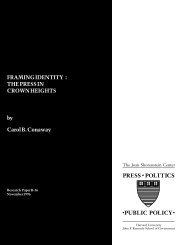Why Paper Is Eternal - Joan Shorenstein Center on the Press ...
Why Paper Is Eternal - Joan Shorenstein Center on the Press ...
Why Paper Is Eternal - Joan Shorenstein Center on the Press ...
Create successful ePaper yourself
Turn your PDF publications into a flip-book with our unique Google optimized e-Paper software.
Introducti<strong>on</strong> *<br />
The c<strong>on</strong>diti<strong>on</strong> of American journalism in <strong>the</strong> first decade of <strong>the</strong> twenty-<br />
first century can be expressed in a single unhappy word: crisis. Whe<strong>the</strong>r it’s a<br />
plagiarism scandal at a leading newspaper, <strong>the</strong> fall from grace of a network<br />
anchorman or a reporter behind bars, <strong>the</strong> news about <strong>the</strong> news seems to be <strong>on</strong>e<br />
emergency after ano<strong>the</strong>r. But <strong>the</strong> crisis that has <strong>the</strong> greatest potential to<br />
undermine what <strong>the</strong> craft does best is a quiet <strong>on</strong>e that rarely draws <strong>the</strong> big<br />
headlines: <strong>the</strong> crisis of paper. <str<strong>on</strong>g>Paper</str<strong>on</strong>g>’s l<strong>on</strong>g career as a medium of human<br />
communicati<strong>on</strong>, and in particular as a purveyor of news, may be ending.<br />
Exhibit A is <strong>the</strong> newspaper industry, which is in decline largely because<br />
of competiti<strong>on</strong> from newer media outlets, especially <strong>on</strong> <strong>the</strong> Internet. Shrinking<br />
circulati<strong>on</strong> and ad revenues, toge<strong>the</strong>r with rising newsprint costs, are chipping<br />
away at <strong>the</strong> enormous profit margins American newspaper publishers have<br />
enjoyed for decades, throwing <strong>the</strong> medium’s future into doubt. Newspapers<br />
have been losing readers for many years, but recently <strong>the</strong> rate of <strong>the</strong> decline has<br />
accelerated. Between 2003 and 2006, U.S. dailies saw <strong>the</strong>ir total circulati<strong>on</strong> fall<br />
by 6.3 percent for daily editi<strong>on</strong>s, while Sunday circulati<strong>on</strong> was down 8 percent. 1<br />
The percentage of Americans who read a newspaper every day has fallen from<br />
about 70 percent in 1972 to less than 35 percent in 2006. 2 “Few in <strong>the</strong> industry<br />
are now saying <strong>the</strong> downward trend can be reversed,” according to a recent<br />
report by <strong>the</strong> Project for Excellence in Journalism. 3 It seems entirely possible<br />
that five or ten years from now, newspapers will no l<strong>on</strong>ger exist, at least not in<br />
* Ben Reno-Weber, a graduate student at <strong>the</strong> John F. Kennedy School of Government and <strong>the</strong> Harvard<br />
Business School , c<strong>on</strong>tributed enormously to this paper, not just as my research assistant but as a sounding<br />
board, original thinker, lunch compani<strong>on</strong> and tireless cheerleader. I am grateful to him and to <strong>the</strong> <str<strong>on</strong>g>Joan</str<strong>on</strong>g><br />
<str<strong>on</strong>g>Shorenstein</str<strong>on</strong>g> <str<strong>on</strong>g>Center</str<strong>on</strong>g> <strong>on</strong> <strong>the</strong> <strong>Press</strong>, Politics and Public Policy, whose faculty and staff are as generous, supportive<br />
and kind a group of people as I have ever known.


